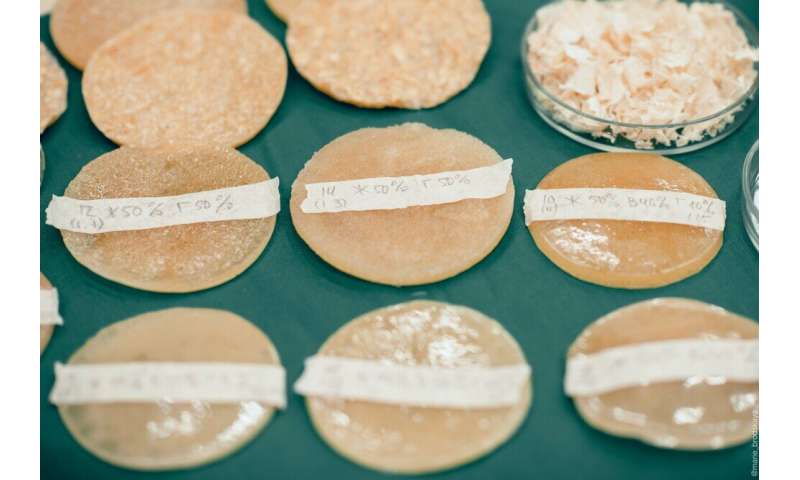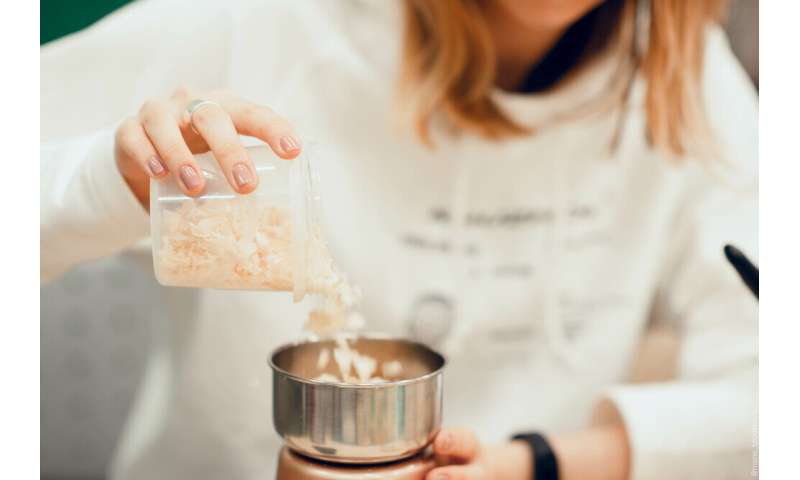Bioplastic based on gelatin and sawdust for home production

A student of the NUST MISIS Master's program "Technologies and materials for digital production" has created a new material based on renewable resources (biocomposite) from wood waste, gelatin, glycerin and water. Such materials are an alternative to traditional plastics that minimizes harm to the environment. Due to the lack of access to the laboratory during quarantine, the student adapted the manufacturing method for home conditions. This can be useful for small-scale production.
Only five percent of all plastics produced worldwide are recycled and reused. In this connection, along with conscious consumption, a trend is formed in the world for conscious production—the creation of objects from initially more environmentally friendly materials.
NUST MISIS student Valeria Solovyova supported this trend in her final master's thesis and proposed the idea of making bioplastics based on gelatin and sawdust.
"The idea came about by accident when I noticed a large amount of sawdust that remains from the milling machine (FlexiCAM) in our FabLab. I came up with the idea that this is a good organic filler and you can mix it with something, study the properties, see if it makes the material stronger. Of course, using sawdust from plywood cut on a milling machine is not the best option because of the contained glue and formaldehyde, but finding a new use for sawdust as a massive waste of woodworking became an interesting task for me. In my work I used clean coniferous sawdust," says the author of the work.

The student also noted that now you can find many biocomposites made on the basis of organic fillers (coffee pomace, nutshells, plant fibers, etc.), and there are practically no examples of using an organic matrix (binder). Therefore, such materials cannot be called environmentally friendly, since one of their parts is synthetic.
In her work, Valeria used an organic matrix consisting of gelatin and glycerin. Such material can be used for the manufacture of household items that do not require high quality and precision, for example, containers for storing dry food or various little things. Bioplastics can be used to produce disposable tableware or thin films for packaging or making bags. It can be also used to produce plant pots, which are then placed in the soil, decomposed and at the same time serve as fertilizer. The main advantage of such bioplastics is its environmental friendliness, the possibility of composting or mulching.
Due to the quarantine and lack of access to the laboratory, samples were made in an out-of-laboratory environment with variable temperature and humidity. Due to the lack of instrumental assessment tools, the samples were evaluated organoleptically according to the developed scale from 1 to 10 points according to five criteria.

"By my first education, I am a designer (I was engaged in graphics, contemporary art and public spaces). I came to the FabLab master's program to master technologies for creating installations or furniture. During my studies, I became interested in ecology, materials and their processing. Now, ideally, I would like to try to shape a tabletop or a chair from the material received," the student notes.
In the future, Valeria Solovyova plans to study the possibility of making materials in the laboratory conditions and the prospects for processing on production equipment. Also, she wants to study the molding of more complex and large forms and the manufacture of master models for casting.
Provided by The National University of Science and Technology MISIS